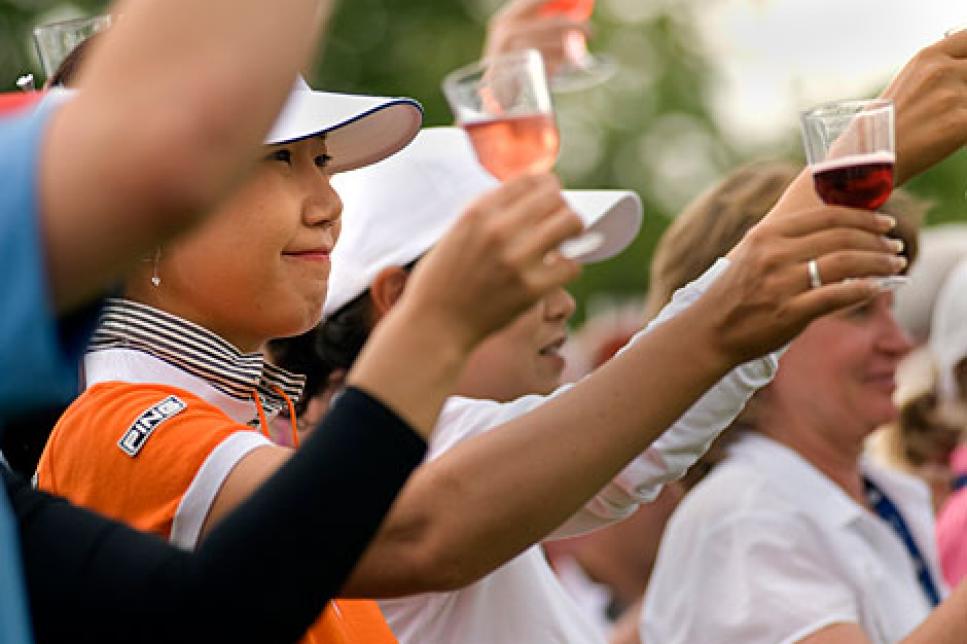News
One Last Time With Feeling

farewell to an old friend: LPGA player Beth Bader (above) was among those saying goodbye to the event after a 31-year run at Corning CC. The neighborly town embraced the tourney in a storybook way. The small touches included a downtown scoreboard (below), where a volunteer removed winner Tseng's name not long after the completion of the final round.
While only time will tell if the Vision 2010 business plan established by commissioner Carolyn Bivens succeeds, the birthing pains of the new reality were felt strongly at the last Corning Classic, at 31 years the longest-running LPGA event held on the same course with the same sponsor. While the atmosphere in this tiny south-central New York town was more celebratory than funereal, there was also a bit of melancholy, akin to bidding farewell to an old friend with the hope the separation is more of a parting than a passing. There was also a spirit in this remarkably resilient community that hinted the LPGA could end up missing Corning more than Corning misses the LPGA.
Most everyone agrees the demise of the Corning Classic marks the end of an era for the LPGA. The new era, however, is uncharted. The tour almost certainly will have fewer tournaments—at least in the short term—and a greater percentage of events outside the United States. Perhaps fields will also be smaller—the Asia model is about 70 players with no cut—and purses may be reduced as the global economy resets itself.
The one inarguable strength the LPGA possesses, however, is a broad-based talent pool. All that's missing is its Tiger Woods, a supremely dominant player to strut upon the world stage and draw fans from outside the base. (Oh, Michelle Wie where have you gone?) And that's exactly why communities like Corning are so important to the LPGA. Here, everyone is treated like Tiger Woods.
"It's really sad," said Natalie Gulbis after playing her final round at Corning CC. "It was sad last night when we were talking about it, and it was sad after every single hole you played. People would say such nice things. I played here seven years, and I am going to miss coming here and the support we got from the people."
What's also missing is a robust global economy to support the tour. "With the way the world is right now, there definitely is concern this won't be the last tournament to go away this year," Gulbis said. "I know there are [more than a dozen] tournaments up for renewal. So we are keeping our fingers crossed. Events like this are really the backbone of the tour. There is so much history here—31 years—and it's sad to lose it."
Over the last year, the LPGA has lost the Fields Open, Ginn Open, Ginn Tribute, SemGroup Championship, SBS Open and ADT Championship. This year's Bell Micro LPGA Classic has been pushed back to 2010. The LPGA Tour Championship will be played in November at the Houstonian GCC, apparently without Stanford Financial as the title sponsor. The Phoenix stop does not have a sponsor for next year, nor does the LPGA Championship, which will lose McDonald's after this year's tournament.
InBev, the new owners of Anheuser-Busch, are lukewarm at best about continuing the Michelob Ultra Open at Kingsmill, and the LPGA event at Kapalua will likely go away unless a title sponsor is found, especially since Seoul Broadcasting System, former sponsor of the SBS Open, recently signed a 10-year deal with the PGA Tour to sponsor what was the Mercedes-Benz Championship at Kapalua.
J Golf, the Korean cable outlet that outbid SBS for the Korean TV rights to the LPGA beginning next year, will sponsor a tournament in Southern California. Already, 11 LPGA events are played outside the United States —five in Asia, three in Mexico, two in Europe and one in Canada.
"We are fully aware of the realities that the current economic downturn presents all our tournaments," said Bivens, "which is why we have been flexible working with both individual tournaments with specific challenges and the tournaments as a whole."
Bivens cited as examples allowing flexibility to Bell Micro and the decision to delay for a year the scoreboard costs being transferred from the tour to the tournaments. She said it was too early to speculate how many events would be on next year's schedule.

Since Penny Pulz won the first Corning Classic in 1979—10 years before this year's winner Yani Tseng was born (see page 35)—the tournament has epitomized the tour's most loyal fans. In the eyes of the locals, LPGA players are superstars, and they were made to feel that way.
Corning, a city built up by the Corning Inc. glassworks, has fewer than 11,000 people. Some years, as many as 50,000 people turned out over four days, which means the daily attendance at times exceeded the population of Corning. The community embraced the tournament in a storybook way.
This year, 56 of the 147 players stayed with families, reflecting friendships developed over the years. A leader board sat on Centerway Square off Market Street in front of Corning's clock tower. In years past the Wegmans supermarket constructed an 18-hole miniature golf course in its store aisles and held contests for customers, each hole having the theme of the product aisle it occupied. Stores on Market Street, the main commercial district, decorated their windows in golf motifs and players would judge the best.
At Aniello's Pizzeria or The Glory Hole Pub Eatery, a bar named for the furnace used to heat glass, players mixed easily with the locals. This year, the Glory Hole greeted customers with a sign reading: "Welcome LPGA Golfers, Caddies and Fans. We will Miss You!" The Thursday night farewell party featured a pitcher of beer and a bucket of wings for $15.
"They'll be back, they have to," said David O'Brian, a customer at the Glory Hole. "We need to keep it here," said Linda Jellif. "This is what makes Corning Corning." Then she hit on the slight many in the community felt. "Hey, we're just a small town, and the LPGA is going away because we're so small," says Jellif. "But I guess if we weren't a small town all of us would go away. This is the way we like it."

Mayor Tom Reed, who played in two pro-ams at this year's Classic, in many ways represents the typical fan. "Corning is my hometown, my family's hometown, my grandparent's hometown," he said. "It's a small community. Having the LPGA here all these years is one of the things that identifies our community. It's a world-class event, and it's become one of those things we all look forward to as a city as a kickoff to the summer season, as a kickoff to the tourist season."
The potential impact on the local economy from losing the tournament is estimated by Elmira College to be as much as $15 million a year. But already local leaders are looking for something else to occupy Memorial Day weekend and lead into the Finger Lakes and wine region tourist season. A music festival is one idea, or a Nationwide Tour or Champions Tour event. "That's a significant sum, but not such an amount that we can't overcome it," Reed says.
The owners of the Corning Classic had an option for 2010 but chose not to exercise it. They say the cost for 2010 was projected to go up as much as $300,000 and for 2011, when the purse was to increase from $1.5 million to $1.7 million, the total cost increase would be $675,000. The television production costs under the LPGA's new 10-year deal with Golf Channel would have increased from $255,000 a year to $425,000 in 2010 with 5 percent increases each year though 2013, tournament officials said.
"I want to be clear about one thing," said Jack Benjamin, chairman of the Corning Classic. "The LPGA itself did not drive us out of business. The increase in costs didn't help, but it wasn't the primary driver." Benjamin said a 50-percent drop in sponsorship support—down $500,000 this year—and recent layoffs at Corning Inc. were the culprits.
The Corning Classic was the victim of a perfect storm of events. The global recession, which led to a 13-percent workforce reduction at Corning Inc.—650 jobs in Corning alone—and the loss of sponsorship revenue were factors beyond anyone's control. Many others however—players, officials and fans—questioned the decision by the LPGA to go ahead with its Vision 2010 business plan, which imposes significant added costs to tournaments, in this economy.
"Any attempt to paint the demise of Corning as anything other than a victim of the economic downturn is inaccurate and frankly disappointing," said David Higdon, chief communications officer of the LPGA.
Bivens wants to drive up purses and improve benefits for players, especially the tour's pension. But that means added costs for tournaments. Specifically, the tour wants events to pay the full cost for the scoreboards (now shared with the LPGA), and a six-figure increase in the sanction fee as well as making tournaments pay half of Golf Channel's production costs. She couldn't have had worse luck on timing.
While the LPGA was willing to postpone the scoreboard costs and put the sanctioning fee on the table for discussion, these were offered only as short-term solutions—a delay of one year—rather than complete rollbacks. The Corning organizers looked at the long term and decided they couldn't make the numbers work.
"We were very desirous of continuing, but as we moved forward some things began to change—some LPGA fees, Golf Channel fees, the purse increase," said Tom Tranter, president of Corning Enterprises and the tournament's vice chairman. "But all the way to November or December it looked like a renewal was very much in the cards." Then the Classic lost $500,000 worth of sponsors in its $3.5 million budget.
Bill Whitney, a research scientist for Corning Inc. for 27 years, now retired, has volunteered at the Classic for 11 years, the last eight working the leader board off the 18th fairway. "If it was just Corning they were losing, I'd say it was Corning," says Whitney. "But [the LPGA] has a different business model, looking for larger markets, off-shore markets, and they are not terribly concerned about their roots."
Saturday night, as the deejay at the Glory Hole played "Another One Bites the Dust," about a half-dozen caddies sang along, appreciating the dark humor. Sunday, as Benjamin prepared to present the winner's trophy to Tseng, a voice called out, "One more year. Come on Jack, make it happen."
Not next year, or the year after. But perhaps after that. "We think that by the end of 2011 a lot of this [the economy] will reset itself at 20 to 30 percent lower," says Benjamin. "When that happens, we will take another look. We love the LPGA. There has never been any question about our passion and love for the LPGA players. But you have to make the economics work."
With that, workers began to dismantle the leader boards of the last Corning Classic. "It's a bummer," says Michele Redman, an 18-year tour veteran. "I'm going to miss playing here." Redman's caddie, Joe Connolly, who has been at every Corning Classic and caddied in all but one, tapped his heart and said, "It hurts rights here."
That pretty much summed it up for everyone. It was a pain too great for any price tag.

